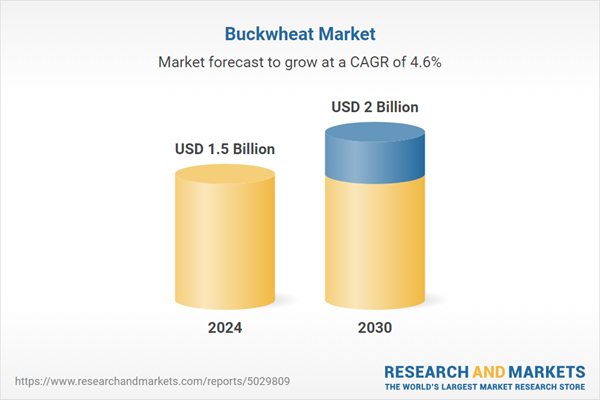The global market for Buckwheat was valued at US$1.5 Billion in 2024 and is projected to reach US$2.0 Billion by 2030, growing at a CAGR of 4.6% from 2024 to 2030. This comprehensive report provides an in-depth analysis of market trends, drivers, and forecasts, helping you make informed business decisions. The report includes the most recent global tariff developments and how they impact the Buckwheat market.
Segments: Form (Groats, Flour, Flakes); Nature (Conventional, Organic); End-Use (Food & Beverage, Animal Feed, Cosmetics & Personal Care, Other End-Uses).
Geographic Regions/Countries: World; United States; Canada; Japan; China; Europe (France; Germany; Italy; United Kingdom; Spain; Russia; and Rest of Europe); Asia-Pacific (Australia; India; South Korea; and Rest of Asia-Pacific); Latin America (Argentina; Brazil; Mexico; and Rest of Latin America); Middle East (Iran; Israel; Saudi Arabia; United Arab Emirates; and Rest of Middle East); and Africa.
The analysts continuously track trade developments worldwide, drawing insights from leading global economists and over 200 industry and policy institutions, including think tanks, trade organizations, and national economic advisory bodies. This intelligence is integrated into forecasting models to provide timely, data-driven analysis of emerging risks and opportunities.
Global Buckwheat Market - Key Trends and Drivers Summarized
Why Is Buckwheat Gaining Popularity as a Superfood?
Buckwheat has experienced a significant resurgence in popularity, primarily because of its impressive nutritional profile and its classification as a gluten-free pseudo-cereal. Unlike its misleading name suggests, buckwheat is not a type of wheat, nor is it related to typical cereal grains. Instead, it belongs to the same family as rhubarb and sorrel, making it an ideal option for people with gluten intolerances or those looking to diversify their diet with more nutrient-dense foods. Nutritionally, buckwheat stands out due to its high levels of protein, dietary fiber, and essential minerals like magnesium, copper, and manganese, all of which play crucial roles in supporting heart health, regulating blood sugar levels, and improving overall digestion. In addition, it is rich in flavonoids, especially rutin, an antioxidant compound known for its potential anti-inflammatory properties and cardiovascular benefits. The combination of these nutrients has led health experts to champion buckwheat as a superfood, particularly as more consumers seek out whole, unprocessed foods that contribute to long-term health. With its versatility in both savory and sweet dishes, from traditional Japanese soba noodles to gluten-free pancakes and porridge, buckwheat has found its way into a wide variety of meals, contributing to its rising status as a dietary staple in health-conscious households worldwide.How Are Global Dietary Trends Impacting the Demand for Buckwheat?
The shifting dynamics of global dietary preferences have been a critical factor in the increasing demand for buckwheat, particularly as more people move towards plant-based and whole-food diets. Vegetarian and vegan diets are now more popular than ever, with a significant portion of the population seeking out plant-based sources of protein that offer the essential amino acids typically found in animal products. Buckwheat meets this demand due to its unique protein profile, which includes all nine essential amino acids, making it comparable to other highly valued pseudo-cereals like quinoa. Simultaneously, the rise of gluten-free diets, driven both by medical needs such as celiac disease and by general lifestyle choices, has propelled buckwheat into the spotlight as a versatile, gluten-free grain substitute. Buckwheat flour and groats are now commonly used in a wide range of gluten-free products, from baked goods to pastas, fulfilling consumer demand for alternatives to wheat-based foods without compromising on texture or nutritional value. Beyond gluten-free diets, the clean-eating movement, which emphasizes whole, minimally processed foods, has further bolstered buckwheat's appeal. As consumers become more aware of the benefits of nutrient-dense grains and seek foods that align with their health and sustainability values, buckwheat’s demand has expanded globally, positioning it as a key ingredient in various modern culinary trends.Why Is Buckwheat Becoming an Agricultural Powerhouse?
Buckwheat’s rise in popularity is not limited to its consumption but also stems from its growing importance as a sustainable crop in modern agriculture. One of the reasons buckwheat is so favored by environmentally conscious farmers is its ability to thrive in poor soil conditions without the need for synthetic fertilizers or heavy irrigation. Unlike many conventional crops, buckwheat requires relatively few inputs to grow, making it an excellent choice for farmers seeking to reduce their environmental footprint. Its short growing cycle allows it to be planted and harvested within a few months, making it suitable for regions with challenging climates or for farmers looking to diversify their crop rotations. Buckwheat is also a natural weed suppressant due to its rapid growth and dense canopy, which blocks sunlight and prevents weeds from taking root. This not only reduces the need for herbicides but also improves soil health, contributing to long-term agricultural sustainability. Moreover, buckwheat's ability to attract pollinators like bees enhances biodiversity on farms, promoting healthier ecosystems. As sustainability becomes a more pressing concern for both producers and consumers, buckwheat’s role in environmentally friendly farming practices is gaining recognition, making it a highly attractive crop in both commercial agriculture and organic farming circles.What Are the Factors Fueling the Growth of the Buckwheat Market?
The growth in the buckwheat market is driven by several factors, each playing a pivotal role in its increasing global prominence. One of the most significant drivers is the rising demand for healthier, gluten-free, and nutrient-dense food options. As consumers become more informed about the nutritional value of foods, they are turning to buckwheat for its high protein content, fiber, and essential minerals, as well as its ability to support heart health, digestive function, and blood sugar regulation. Additionally, the ongoing shift toward plant-based diets has significantly increased demand for buckwheat as a reliable source of plant-based protein that provides all essential amino acids. In the food industry, buckwheat’s versatility in both traditional and modern culinary applications, such as in gluten-free baked goods, porridges, and noodles, has helped expand its presence in diverse markets. Technological advancements in food processing have also led to the development of new buckwheat-based products, such as gluten-free snacks and flours, which appeal to a broad range of consumers seeking healthy, innovative food solutions. Furthermore, buckwheat’s status as a sustainable crop that aligns with environmental and regenerative agriculture trends has made it an appealing choice for farmers and food companies looking to meet growing consumer expectations for eco-friendly and ethically produced goods. Government initiatives supporting the cultivation of sustainable crops and promoting healthier diets, alongside the expansion of organic farming practices, are further accelerating the growth of the buckwheat market, ensuring that this once-underutilized crop continues to flourish on the global stage.Report Scope
The report analyzes the Buckwheat market, presented in terms of units. The analysis covers the key segments and geographic regions outlined below.Segments: Form (Groats, Flour, Flakes); Nature (Conventional, Organic); End-Use (Food & Beverage, Animal Feed, Cosmetics & Personal Care, Other End-Uses).
Geographic Regions/Countries: World; United States; Canada; Japan; China; Europe (France; Germany; Italy; United Kingdom; Spain; Russia; and Rest of Europe); Asia-Pacific (Australia; India; South Korea; and Rest of Asia-Pacific); Latin America (Argentina; Brazil; Mexico; and Rest of Latin America); Middle East (Iran; Israel; Saudi Arabia; United Arab Emirates; and Rest of Middle East); and Africa.
Key Insights:
- Market Growth: Understand the significant growth trajectory of the Buckwheat Groats segment, which is expected to reach US$956.3 Million by 2030 with a CAGR of a 4.3%. The Buckwheat Flour segment is also set to grow at 5.1% CAGR over the analysis period.
- Regional Analysis: Gain insights into the U.S. market, valued at $400.5 Million in 2024, and China, forecasted to grow at an impressive 6.8% CAGR to reach $428.9 Million by 2030. Discover growth trends in other key regions, including Japan, Canada, Germany, and the Asia-Pacific.
Why You Should Buy This Report:
- Detailed Market Analysis: Access a thorough analysis of the Global Buckwheat Market, covering all major geographic regions and market segments.
- Competitive Insights: Get an overview of the competitive landscape, including the market presence of major players across different geographies.
- Future Trends and Drivers: Understand the key trends and drivers shaping the future of the Global Buckwheat Market.
- Actionable Insights: Benefit from actionable insights that can help you identify new revenue opportunities and make strategic business decisions.
Key Questions Answered:
- How is the Global Buckwheat Market expected to evolve by 2030?
- What are the main drivers and restraints affecting the market?
- Which market segments will grow the most over the forecast period?
- How will market shares for different regions and segments change by 2030?
- Who are the leading players in the market, and what are their prospects?
Report Features:
- Comprehensive Market Data: Independent analysis of annual sales and market forecasts in US$ Million from 2024 to 2030.
- In-Depth Regional Analysis: Detailed insights into key markets, including the U.S., China, Japan, Canada, Europe, Asia-Pacific, Latin America, Middle East, and Africa.
- Company Profiles: Coverage of players such as Archer Daniels Midland Company, Bio-Oz. Buckwheat Enterprises Pty Ltd, Bob's Red Mill Natural Foods, Ceres Organics, Doves Farm Foods Ltd. and more.
- Complimentary Updates: Receive free report updates for one year to keep you informed of the latest market developments.
Some of the 56 companies featured in this Buckwheat market report include:
- Archer Daniels Midland Company
- Bio-Oz. Buckwheat Enterprises Pty Ltd
- Bob's Red Mill Natural Foods
- Ceres Organics
- Doves Farm Foods Ltd.
- Hodgson Mill, Inc.
- Homestead Organics Ltd
- Montana Milling Inc.
- Skvyrskyi grain processing factory Ltd.
- The Birkett Mills
- The Hain Celestial Group, Inc.
- UAB Galinta Ir Partneriai
- Wilmar International Ltd.
- Windmill Organics Ltd.
Tariff Impact Analysis: Key Insights for 2025
Global tariff negotiations across 180+ countries are reshaping supply chains, costs, and competitiveness. This report reflects the latest developments as of April 2025 and incorporates forward-looking insights into the market outlook.The analysts continuously track trade developments worldwide, drawing insights from leading global economists and over 200 industry and policy institutions, including think tanks, trade organizations, and national economic advisory bodies. This intelligence is integrated into forecasting models to provide timely, data-driven analysis of emerging risks and opportunities.
What’s Included in This Edition:
- Tariff-adjusted market forecasts by region and segment
- Analysis of cost and supply chain implications by sourcing and trade exposure
- Strategic insights into geographic shifts
Buyers receive a free July 2025 update with:
- Finalized tariff impacts and new trade agreement effects
- Updated projections reflecting global sourcing and cost shifts
- Expanded country-specific coverage across the industry
Table of Contents
I. METHODOLOGYII. EXECUTIVE SUMMARY2. FOCUS ON SELECT PLAYERSIII. MARKET ANALYSISCANADAITALYSPAINRUSSIAREST OF EUROPESOUTH KOREAREST OF ASIA-PACIFICARGENTINABRAZILMEXICOREST OF LATIN AMERICAIRANISRAELSAUDI ARABIAUNITED ARAB EMIRATESREST OF MIDDLE EASTIV. COMPETITION
1. MARKET OVERVIEW
3. MARKET TRENDS & DRIVERS
4. GLOBAL MARKET PERSPECTIVE
UNITED STATES
JAPAN
CHINA
EUROPE
FRANCE
GERMANY
UNITED KINGDOM
ASIA-PACIFIC
AUSTRALIA
INDIA
LATIN AMERICA
MIDDLE EAST
AFRICA
Companies Mentioned (Partial List)
A selection of companies mentioned in this report includes, but is not limited to:
- Archer Daniels Midland Company
- Bio-Oz. Buckwheat Enterprises Pty Ltd
- Bob's Red Mill Natural Foods
- Ceres Organics
- Doves Farm Foods Ltd.
- Hodgson Mill, Inc.
- Homestead Organics Ltd
- Montana Milling Inc.
- Skvyrskyi grain processing factory Ltd.
- The Birkett Mills
- The Hain Celestial Group, Inc.
- UAB Galinta Ir Partneriai
- Wilmar International Ltd.
- Windmill Organics Ltd.
Table Information
| Report Attribute | Details |
|---|---|
| No. of Pages | 332 |
| Published | April 2025 |
| Forecast Period | 2024 - 2030 |
| Estimated Market Value ( USD | $ 1.5 Billion |
| Forecasted Market Value ( USD | $ 2 Billion |
| Compound Annual Growth Rate | 4.6% |
| Regions Covered | Global |









